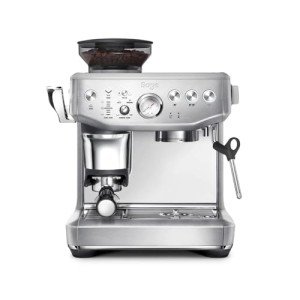5 Qualities People Are Looking For In Every Home Espresso Machines
The Rise of Home Espresso Machines: A Comprehensive Guide
As coffee lovers continue to look for fresh and delicious brews in the house, the appeal of home espresso machines has risen recently. No longer just the domain of coffee shops and coffee shops, these machines empower people to craft barista-quality espresso drinks from the comfort of their cooking areas. This post will explore the numerous kinds of home espresso machines, their functions, and considerations for picking the right one. In addition, it will provide a choice of FAQs to help potential buyers make notified choices.
Types of Home Espresso Machines
Home espresso machines can be classified into numerous classifications based upon their mechanisms and user-friendliness. Commercial Espresso Machines has its special features, pros, and cons.
Type
Description
Pros
Cons
Manual Espresso Machines
Requires the user to by hand control the developing process, involving techniques like pulling a lever to develop pressure.
- Complete control over brewing procedure
- Compact style
- Requires ability and practice
- Time-consuming
Semi-Automatic Machines
Machine automates water circulation and pressure, however the user still controls the dosing and period of the brewing process.
- Balance of automation and control
- Versatile
- Learning curve for improving strategies
Completely Automatic Machines
Automates the whole developing procedure, from grinding to developing, frequently with programmable settings for personalized drinks.
- Extremely user-friendly
- Quick and convenient
- Less control over the developing procedure
- Higher price point
Capsule or Pod Machines
Uses pre-packaged espresso capsules or pods to produce coffee quickly and easily.
- Extremely simple to use
- Minimal clean-up
- Limited taste range
- More expensive per cup than ground coffee
Super-Automatic Machines
Integrates functions of totally automatic machines with integrated mills, allowing users to brew whole bean espresso and milk-based beverages with one touch.
- All-in-one convenience
- Ideal for milk-based drinks
- Often the most pricey
- Can be bulky
Functions to Consider
When choosing a home espresso machine, possible buyers ought to consider the following features to ensure they select a machine that satisfies their requirements:
Grinder Type:
- Built-in grinders can supply fresher grounds however might need more maintenance.
- Different grinders permit more personalization of grind size.
Pressure:
- Look for machines that produce a minimum of nine bars of pressure, which is optimum for brewing espresso.
Water Temperature Control:
- Machines with adjustable temperature level settings allow for much better extraction of flavor from beans.
Milk Frothing Options:
- Consider whether you want a manual steam wand for frothing or an automatic milk frother for benefit.
Reduce of Cleaning:
- Machines with detachable parts and self-cleaning functions considerably reduce cleanup time.
Size and Design:
- Ensure the machine fits conveniently in your kitchen area and aligns with your visual choices.
Budget:
- Set a budget before starting your search, as rates can range considerably from affordable designs to high-end machines.
Benefits of Home Espresso Machines
Owning a home espresso machine uses numerous benefits:
- Cost-Effective: Over time, brewing espresso in the house can conserve coffee lovers cash compared to regular café check outs.
- Modification: Users can try out different beans, grind sizes, and brewing methods to find their ideal cup.
- Convenience: The capability to brew espresso at any time eliminates the requirement to go out to a café, specifically beneficial throughout late nights or early mornings.
- Quality Control: With a home machine, people have total control over the quality of ingredients and developing processes.
Downsides of Home Espresso Machines
However, there are some drawbacks to consider:
- Initial Investment: High-quality espresso machines can be pricey, needing a substantial in advance financial investment.
- Knowing Curve: Mastering the art of espresso developing can take time and practice, which may be daunting for newbies.
- Maintenance: Like any appliance, espresso machines need regular cleaning and upkeep to ensure optimal efficiency.
FAQs
1. What is the very best kind of home espresso machine for novices?
Response: For newbies, a semi-automatic machine is often suggested as it offers a balance between control and automation, permitting you to discover the essentials without frustrating intricacy.
2. How much should I invest on a home espresso machine?
Answer: Entry-level machines can start around ₤ 100 to ₤ 300, while higher-end models can range from ₤ 500 to over ₤ 2000. It's important to set a budget based upon your expected usage and wanted functions.
3. Do I need a different grinder?
Response: While some espresso machines feature built-in grinders, investing in a different grinder permits higher personalization and makes sure better quality grounds.
4. How frequently should I clean my espresso machine?
Answer: Cleaning frequency can vary by machine type, however it's generally advised to clean up the machine after each use and carry out deep cleanings weekly or monthly, depending on usage.
5. Can see this page make milk-based beverages with any espresso machine?
Response: Not all machines feature milk frothing capabilities. If you enjoy beverages like lattes or cappuccinos, try to find a machine with a steam wand or automatic frother.
Home espresso machines are transforming the way coffee connoisseurs enjoy their precious brews. With different types and advanced functions readily available in the market, there is something for everybody. Whether it's the delight of producing distinct dishes or merely enjoying the ideal shot of espresso, buying a home espresso machine can boost both the coffee-drinking experience and the lifestyle for coffee lovers all over. As with any financial investment, it is crucial to weigh the benefits against the potential downsides and pick a machine that perfectly fits both your way of life and preferences.
